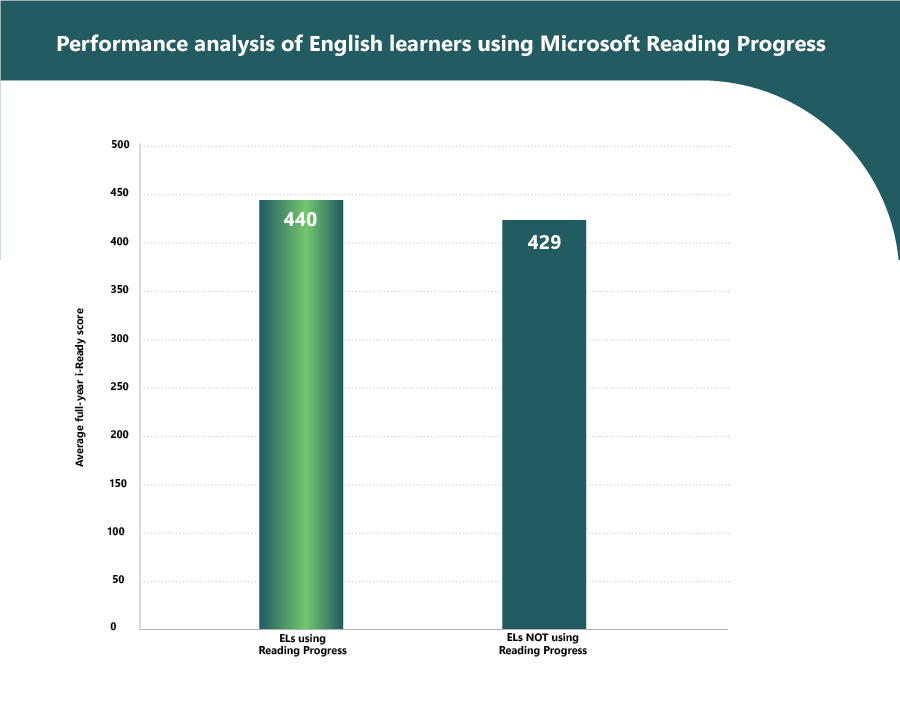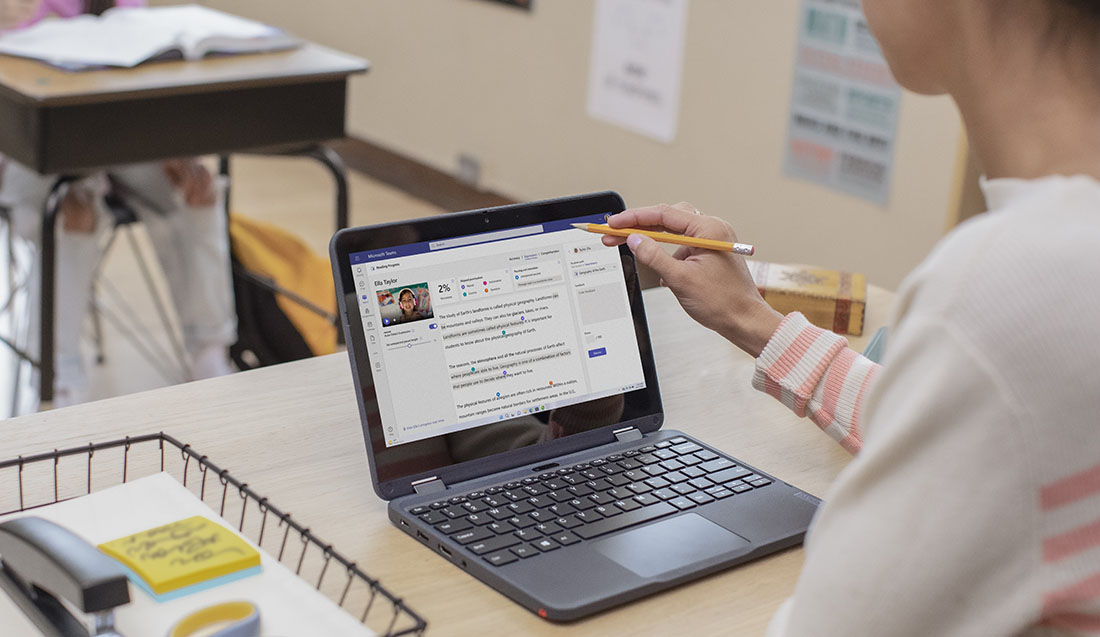Early literacy is the cornerstone of academic success. Researchers at the University of Chicago and other institutions highlight a crucial shift: Up to the end of third grade, most students are “learning to read” while from fourth grade on, they’re “reading to learn.” With this in mind, the drive to improve literacy has prompted districts to begin academic interventions with students when they are younger, identifying and addressing literacy gaps earlier to help students succeed. By focusing on early literacy, districts can set the foundation for long-term success and close achievement gaps.
Fresno Unified School District (FUSD) is the third largest school district in the state of California, US, serving approximately 71,000 students. In August 2023, FUSD launched a literary initiative to help get students reading on grade level by the end of first grade.
To support this initiative, FUSD adopted innovative literacy tools like Reading Progress, a Learning Accelerator from Microsoft. Reading Progress is a powerful reading fluency tool that tracks a student’s reading skills, helping them to focus on specific areas of improvement, while quickly providing actionable insights for educators.
Integrated seamlessly into Microsoft Teams for Education, Reading Progress simplifies the process of creating, reviewing, and analyzing reading assignments. It offers educators and reading specialists valuable data visualizations for both class and individual performance and growth. New enhancements including AI passage generation and AI comprehension questions generation help educators to save time while personalizing learning experiences for students’ needs.
Measuring impact on student achievement
To gain a clearer picture of Reading Progress in the classroom, Microsoft partnered with LearnPlatform to evaluate the impact of the tool on FUSD K-6 students’ reading achievement.
The results were promising. The study found a positive correlation between consistent Reading Progress usage and improved reading outcomes for kindergarten through sixth-grade students. In fact, students who regularly engaged with Reading Progress demonstrated two key improvements: higher reading accuracy and faster reading speeds.
Reading Progress makes my job easier. I used to do fluency individually with the students and it took so much valuable class time. With Reading Progress, they can push themselves to read independently.
Idia Elegbede-Abode, Teacher, Aynesworth Elementary, Fresno, California, US
Study methodology
To ensure the findings about Reading Progress were reliable, researchers utilized an approach that meets the rigorous evidence standards for Level II (Moderate Evidence) under the Every Student Succeeds Act (ESSA). The research employed a quasi-experimental design, a common approach in educational research. This approach compared students who used Reading Progress to those who did not. To enhance the study’s rigor, propensity score matching was used to create comparable groups of students, helping to mitigate potential biases.
The study focused on:
- 1,404 kindergarten through 6th grade students
- 702 who used Reading Progress
- 702 who did not
Researchers collected and analyzed data on:
- Reading Progress usage
- i-Ready reading assessments scores
- Student demographics
The analysis showed that Reading Progress had a positive impact on student reading achievement. This was particularly noticeable for two cases: when students increased usage, and for students from disadvantaged backgrounds. Let’s dig deeper into the results.
Higher gains
Students using Reading Progress consistently showed significantly higher gains in iReady reading scores for both K-2 and grades 3-6 students compared to non-users.
The average i-Ready score among Reading Progress users was 454: significantly higher than the average non-user score of 448.
To put this in perspective, if a student at the 50th percentile had used Reading Progress, they would be expected to perform at the 54th percentile. While this may seem like a modest gain, it represents meaningful progress in reading achievement.
A reading equalizer
Reading Progress was shown to benefit English language learners and students who qualified for free/reduced lunch.
The average full year i-Ready score among English learners who used Reading Progress was 440, significantly higher than the average non-user score of 429.
This difference is significant. An English learner at the 50th percentile using Reading Progress would be expected to perform at the 59th percentile: a jump equivalent to roughly one full grade level.

For Reading Progress users who qualified for free/reduced price lunch, their score was 451 as opposed to the average non-user score of 444. This translates to a possible 50th percentile to 55th percentile jump, indicating that Reading Progress can be a valuable tool in supporting diverse learner populations.
According to elementary school teacher Idia Elegbede-Abode, “Reading Progress makes my job easier. I used to do fluency individually with the students and it took so much valuable class time. With Reading Progress, they can push themselves to read independently. At the end of the day, I look and see where they are, and it helps me to better group the students. Reading Progress has also improved my students’ motivation. And since I assign it as homework, the parents have even been getting involved! In Fourth Grade, you’re not learning how to read, you’re reading to learn. With Reading Progress taking care of fluency, we can use precious class time to focus on comprehension.”
Consistency is key
Students who used Reading Progress more frequently demonstrated higher reading accuracy and faster reading speeds.
Seventy-eight percent of K-2 Reading Progress users submitted between two and five assignments per month that were, on average, 38% accurate. Those who submitted more assignments, however, had a 10% higher average accuracy percentage across their assignments.
For me, the benefits of Reading Progress are that I can have alone time with every kid without having to have alone time with every kid! I can see my students on the screen, I can hear their voices, and I know exactly how they’re reading.
Errin Topolovec, Teacher, Ayer Elementary, Fresno, California, US
Meanwhile, 83% of grade 3-6 Reading Progress users submitted 20 or fewer assignments, with those submitting more assignments scoring six points higher on their full year i-Ready Reading assessment.
These findings suggest that increased engagement with Reading Progress correlates with improved reading performance, highlighting the potential benefits of consistent use.
Errin Topolovec, another elementary school teacher said, “For me, the benefits of Reading Progress are that I can have alone time with every kid without having to have alone time with every kid! I can see my students on the screen, I can hear their voices, and I know exactly how they’re reading. Reading Progress also really helps to drive my instruction. I can look at it and I start taking notes, then pick a targeted group, pull them over, and hit what they really need to learn to become exceptional readers. For my students, they’ve become much better readers because they are far more aware of their own reading.”
How to get started with Reading Progress
Discover student-centered solutions
Explore Microsoft 365 EducationReading Progress is a valuable tool for improving literacy rates across grade levels. This study confirms that consistent use of Reading Progress maximized student benefits and enabled educators to leverage data to inform instruction and provide differentiated support to students. It even shows potential in reducing achievement gaps.
Integrating Reading Progress into a literacy curriculum is simple. Here’s how to get started:
- Create assignments: Educators can easily create an assignment within Microsoft Teams for Education using Reading Progress.
- Student engagement: Students complete the assignment by reading a passage, while recording their voice, and optionally, their video.
- Fluency analysis: Reading Progress then analyzes student reading fluency, checking for pronunciation, inserted words, omitted words, and repeated words.
- Data-driven instruction: Educators then receive data that includes an accuracy percentage and the identified words so that they can tailor instruction accordingly.
Create assignments in Microsoft Teams
Enhance learning with built-in AI tools
Download Microsoft Teams for Education
Educators can easily create a practice assignment with Reading Progress through Assignments in Microsoft Teams for Education. You can use your own Word or PDF file from your computer, OneDrive, Microsoft Teams, Class Notebook or select a passage from the embedded ReadWorks library or use the new passage generator tool.
Personalize passages and assessments with AI-enabled features
Two AI-powered features have been added to Reading Progress, passage and comprehension question generation.
- Passage generation allows educators to create custom passages tailored to the specific needs and reading levels of their students.
- Comprehension questions generation analyzes a specific reading passage and creates true or false, multiple-choice, and fill-in-the-blank questions. You can then customize, add, or delete these questions
Strengthen reading fluency
The standalone Reading Coach Preview app, another Learning Accelerator, complements Reading Progress by providing personalized and engaging reading fluency practice: even at home. It keeps learners motivated by allowing them to create unique AI-generated stories with customizable characters and settings from a curated collection. Reading Coach is available for free as a web app and a Windows app to use in the classroom or at home with a Microsoft account.
Enhance accuracy and track growth in assignments
Reviewing your students’ practice assignments in Reading Progress is straightforward. Easily jump to specific words in the video or audio recording and listen to individual students’ pronunciations.
Reading Progress data is available through the Education Insights dashboard, revealing crucial trends and patterns. Education Insights shows individual, class, or schoolwide student data to help inform targeted initiatives, personalize interventions, and identify areas for improvement in students. This comprehensive data analysis supports administrators in making informed decisions to enhance student outcomes.
Learn more about how Reading Progress can boost literacy in the classroom with these powerful resources.
- Check out Building reading foundational skills: A guide to Reading Progress and Reading Coach in Teams for educators.
- Read how Milton Area School District (US) uses Reading Progress in Microsoft Teams to track students’ reading skills and focus on areas for improvement.
- Learn how The Stour Academy Trust uses Reading Progress and Reading Coach to support students with reading difficulties.
- Take the free training Support reading fluency practice with Reading Progress on Microsoft Learn.








